YAMAHA FX SHO 2012 Manual PDF
Manufacturer: YAMAHA, Model Year: 2012, Model line: FX SHO, Model: YAMAHA FX SHO 2012Pages: 116, PDF Size: 4.49 MB
Page 71 of 116

Pre-operation checks
65
EJU31981
WARNING
EWJ00411
Failure to inspect or maintain the watercraft properly increases the possibility of an ac-
cident or damage to the watercraft. Do not operate the watercraft if you find any prob-
lem. If a problem cannot be corrected by the procedures provided in this manual, have
the watercraft inspected by a Yamaha dealer.
EJU41232Pre-operation checklist
Before using this watercraft, be sure to perform the checks in the following checklist.
ITEM ROUTINE PAGE
PRE-LAUNCH CHECKS
Engine compartmentVentilate the engine compartment.
Check inside the engine compartment for damage.67
Fuel systemCheck the fuel system for leakage.
Check the fuel level in the fuel tank.67
Water separatorCheck the water separator for water. 67
Engine unitCheck the exterior of the engine unit for damage. 68
Engine oil levelCheck the engine oil level. 68
Bilge waterCheck the engine compartment for bilge water. 68
BatteryCheck the battery connections and electrolyte level. 68
Steering systemCheck the steering system for proper operation. 69
Adjustable tilt steering sys-
temCheck the adjustable tilt steering system for proper
operation and check that the handlebars are secure-
ly locked in place.70
Q.S.T.S.Check the Q.S.T.S. for proper operation and check
that the Q.S.T.S. selector is securely locked in place.70
Shift systemCheck the shift system for proper operation. 71
Throttle leverCheck the throttle lever for proper operation. 71
Remote control transmitterCheck the remote control transmitter for proper op-
eration.72
Engine shut-off cord (lan-
yard)Check the engine shut-off cord (lanyard) for dam-
age.72
SwitchesCheck the start switch, engine stop switch, and en-
gine shut-off switch for proper operation.72
Storage compartmentsCheck the storage compartments for damage and
water.72
Fire extinguisher holder,
cover, and bandCheck the fire extinguisher holder, cover, and band
for damage.73
Fire extinguisherCheck the condition of the fire extinguisher. 73
Safety equipmentCheck that safety equipment meeting the applicable
regulations is on board.73
Hull and deckCheck the hull and deck for damage. 73
UF2S70E0.book Page 65 Wednesday, December 7, 2011 3:56 PM
Page 72 of 116

Pre-operation checks
66
TIP:
To ensure safety and reliability, pre-operation checks should be made each time the watercraft
is used.
Jet intakeCheck the jet intake for damage and clogging. 73
Stern drain plugsCheck the stern drain plugs for damage and foreign
material and check that they are securely installed.73
HoodCheck that the hood is securely closed. 74
Front and rear seatsCheck that the seats are securely installed. 49
POST-LAUNCH CHECKS
Cooling water pilot outletCheck that water is discharged from the port (left)
cooling water pilot outlet while the engine is running.74
Multifunction information
centerCheck the multifunction information center for proper
operation.74
Engine idling speedCheck the engine idling speed. 74 ITEM ROUTINE PAGE
UF2S70E0.book Page 66 Wednesday, December 7, 2011 3:56 PM
Page 73 of 116
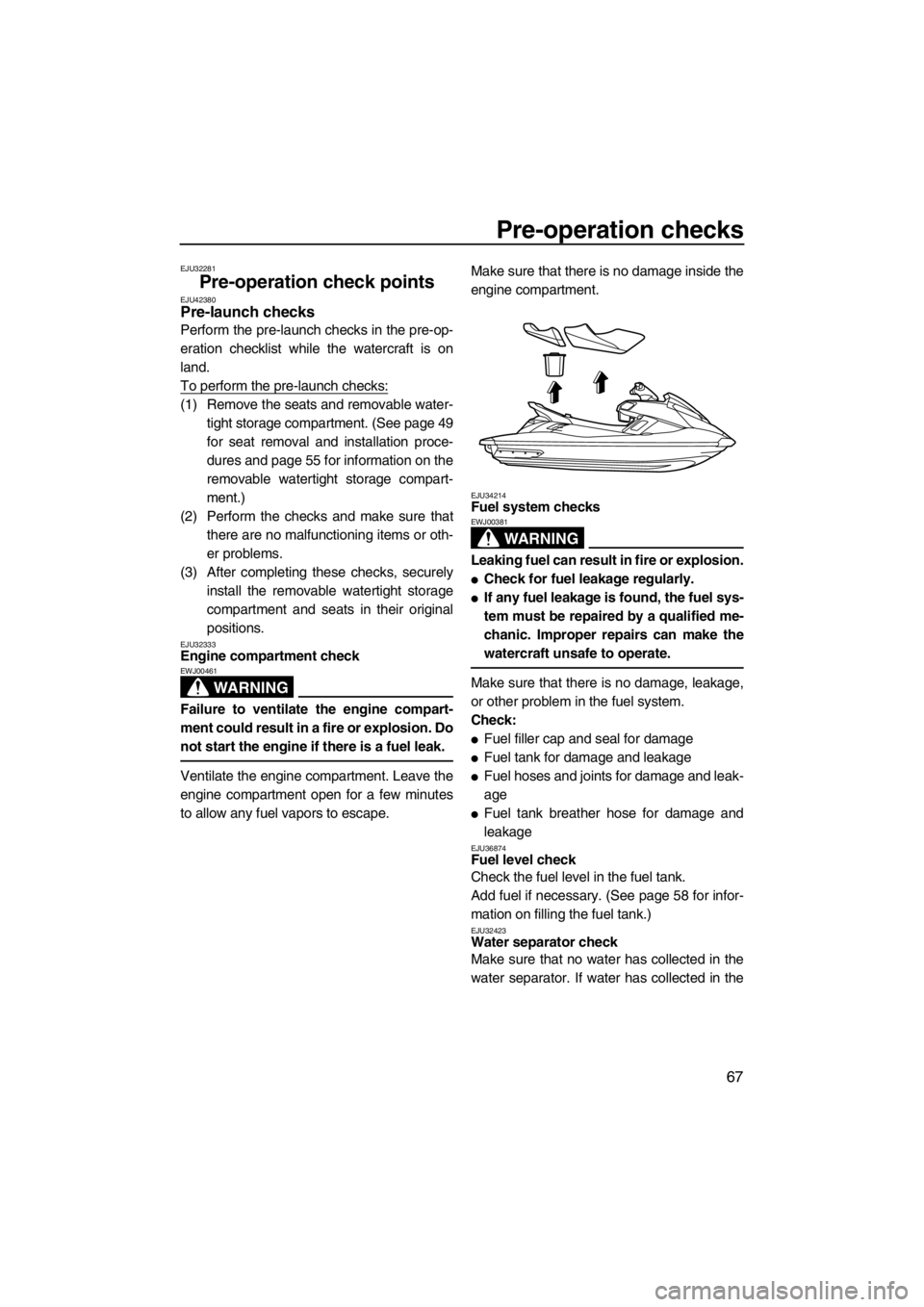
Pre-operation checks
67
EJU32281
Pre-operation check points EJU42380Pre-launch checks
Perform the pre-launch checks in the pre-op-
eration checklist while the watercraft is on
land.
To perform the pre-launch checks:
(1) Remove the seats and removable water-
tight storage compartment. (See page 49
for seat removal and installation proce-
dures and page 55 for information on the
removable watertight storage compart-
ment.)
(2) Perform the checks and make sure that
there are no malfunctioning items or oth-
er problems.
(3) After completing these checks, securely
install the removable watertight storage
compartment and seats in their original
positions.
EJU32333Engine compartment check
WARNING
EWJ00461
Failure to ventilate the engine compart-
ment could result in a fire or explosion. Do
not start the engine if there is a fuel leak.
Ventilate the engine compartment. Leave the
engine compartment open for a few minutes
to allow any fuel vapors to escape.Make sure that there is no damage inside the
engine compartment.
EJU34214Fuel system checks
WARNING
EWJ00381
Leaking fuel can result in fire or explosion.
●Check for fuel leakage regularly.
●If any fuel leakage is found, the fuel sys-
tem must be repaired by a qualified me-
chanic. Improper repairs can make the
watercraft unsafe to operate.
Make sure that there is no damage, leakage,
or other problem in the fuel system.
Check:
●Fuel filler cap and seal for damage
●Fuel tank for damage and leakage
●Fuel hoses and joints for damage and leak-
age
●Fuel tank breather hose for damage and
leakage
EJU36874Fuel level check
Check the fuel level in the fuel tank.
Add fuel if necessary. (See page 58 for infor-
mation on filling the fuel tank.)
EJU32423Water separator check
Make sure that no water has collected in the
water separator. If water has collected in the
UF2S70E0.book Page 67 Wednesday, December 7, 2011 3:56 PM
Page 74 of 116
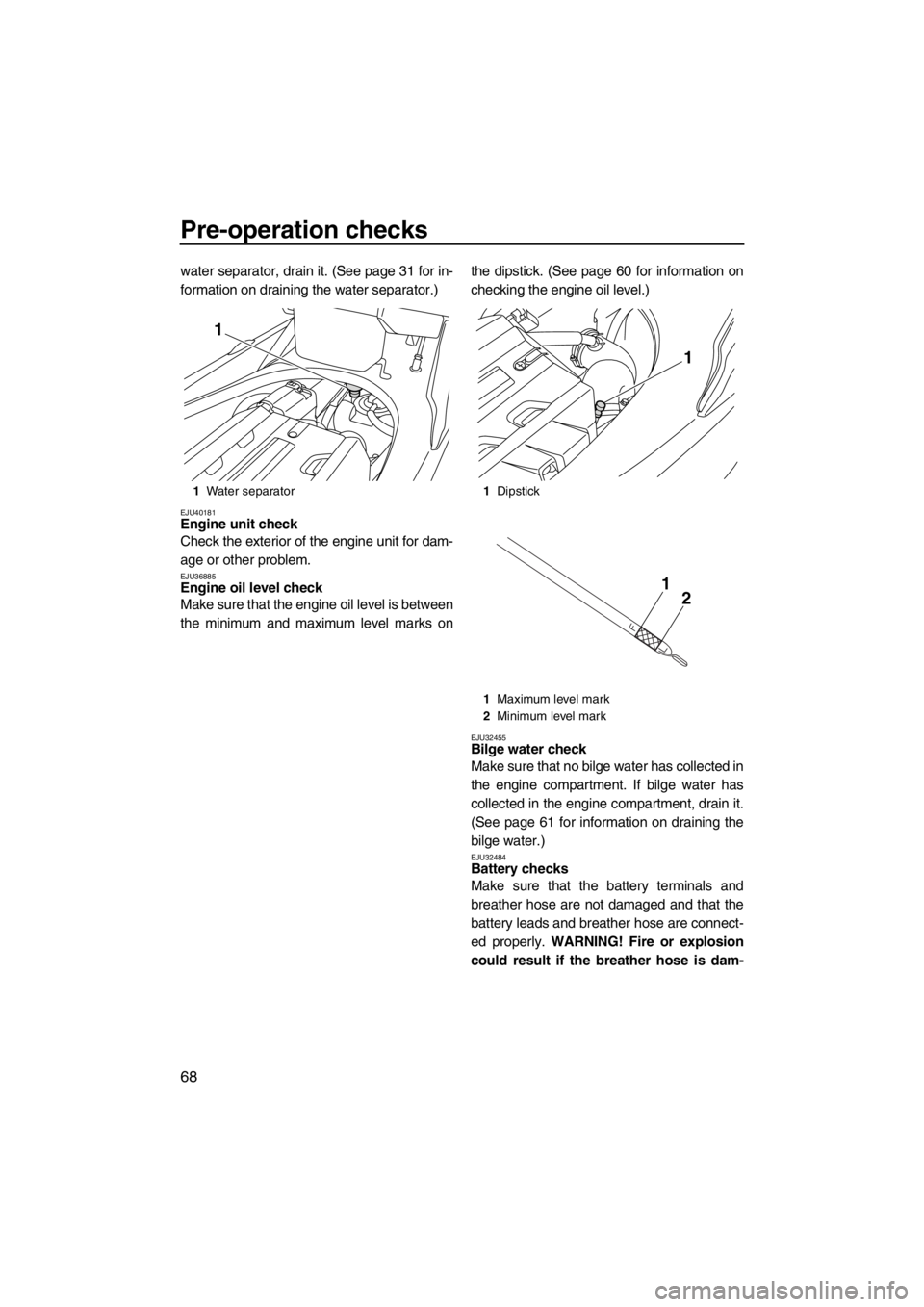
Pre-operation checks
68
water separator, drain it. (See page 31 for in-
formation on draining the water separator.)
EJU40181Engine unit check
Check the exterior of the engine unit for dam-
age or other problem.
EJU36885Engine oil level check
Make sure that the engine oil level is between
the minimum and maximum level marks onthe dipstick. (See page 60 for information on
checking the engine oil level.)
EJU32455Bilge water check
Make sure that no bilge water has collected in
the engine compartment. If bilge water has
collected in the engine compartment, drain it.
(See page 61 for information on draining the
bilge water.)
EJU32484Battery checks
Make sure that the battery terminals and
breather hose are not damaged and that the
battery leads and breather hose are connect-
ed properly. WARNING! Fire or explosion
could result if the breather hose is dam-
1Water separator
1
1Dipstick
1Maximum level mark
2Minimum level mark
1
21
UF2S70E0.book Page 68 Wednesday, December 7, 2011 3:56 PM
Page 75 of 116
![YAMAHA FX SHO 2012 Manual PDF Pre-operation checks
69
aged, obstructed, or not connected prop-
erly.
[EWJ00451]
Make sure that the electrolyte level is be-
tween the minimum and maximum level
marks. WARNING! Never operate the wa- YAMAHA FX SHO 2012 Manual PDF Pre-operation checks
69
aged, obstructed, or not connected prop-
erly.
[EWJ00451]
Make sure that the electrolyte level is be-
tween the minimum and maximum level
marks. WARNING! Never operate the wa-](/img/51/49838/w960_49838-74.png)
Pre-operation checks
69
aged, obstructed, or not connected prop-
erly.
[EWJ00451]
Make sure that the electrolyte level is be-
tween the minimum and maximum level
marks. WARNING! Never operate the wa-
tercraft if the battery does not have suffi-
cient power to start the engine or if it
shows any other signs of decreased pow-
er. Loss of battery power may leave you
stranded.
[EWJ01240]
Make sure that the battery is securely held in
place.
EJU32613Steering system checks
Turn the handlebars to the right and left sev-
eral times to make sure that operation is
smooth and unrestricted throughout thewhole range, and that the free play is not ex-
cessive.
Turn the handlebars as far as possible to the
right and left to make sure that the jet thrust
nozzle moves as the handlebars are turned,
and that there is no difference between the
1Breather hose
2Negative (–) battery terminal: Black lead
3Positive (+) battery terminal: Red lead
1Maximum level mark
2Minimum level mark
23
1
UF2S70E0.book Page 69 Wednesday, December 7, 2011 3:56 PM
Page 76 of 116
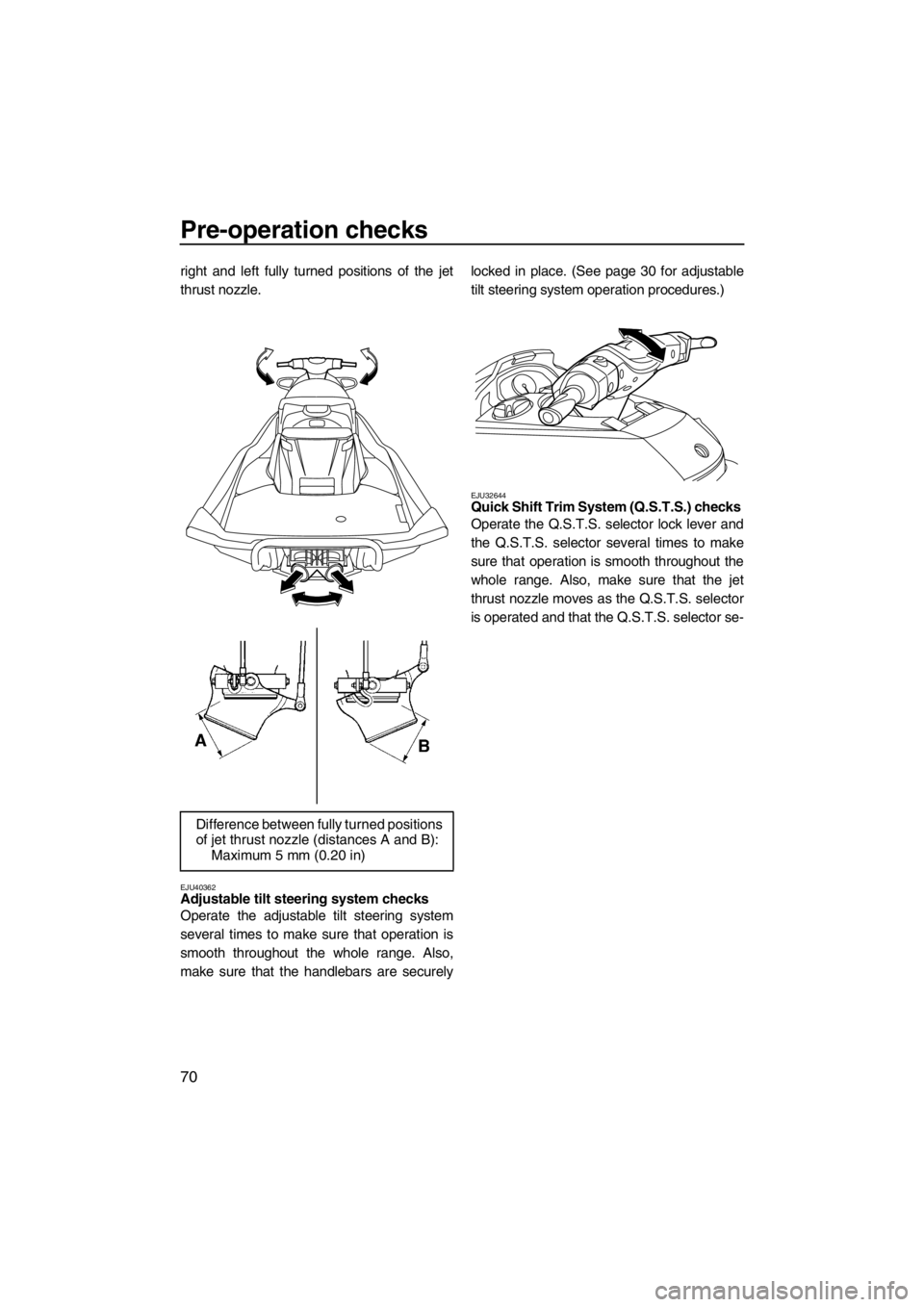
Pre-operation checks
70
right and left fully turned positions of the jet
thrust nozzle.
EJU40362Adjustable tilt steering system checks
Operate the adjustable tilt steering system
several times to make sure that operation is
smooth throughout the whole range. Also,
make sure that the handlebars are securelylocked in place. (See page 30 for adjustable
tilt steering system operation procedures.)
EJU32644Quick Shift Trim System (Q.S.T.S.) checks
Operate the Q.S.T.S. selector lock lever and
the Q.S.T.S. selector several times to make
sure that operation is smooth throughout the
whole range. Also, make sure that the jet
thrust nozzle moves as the Q.S.T.S. selector
is operated and that the Q.S.T.S. selector se-
Difference between fully turned positions
of jet thrust nozzle (distances A and B):
Maximum 5 mm (0.20 in)
UF2S70E0.book Page 70 Wednesday, December 7, 2011 3:56 PM
Page 77 of 116
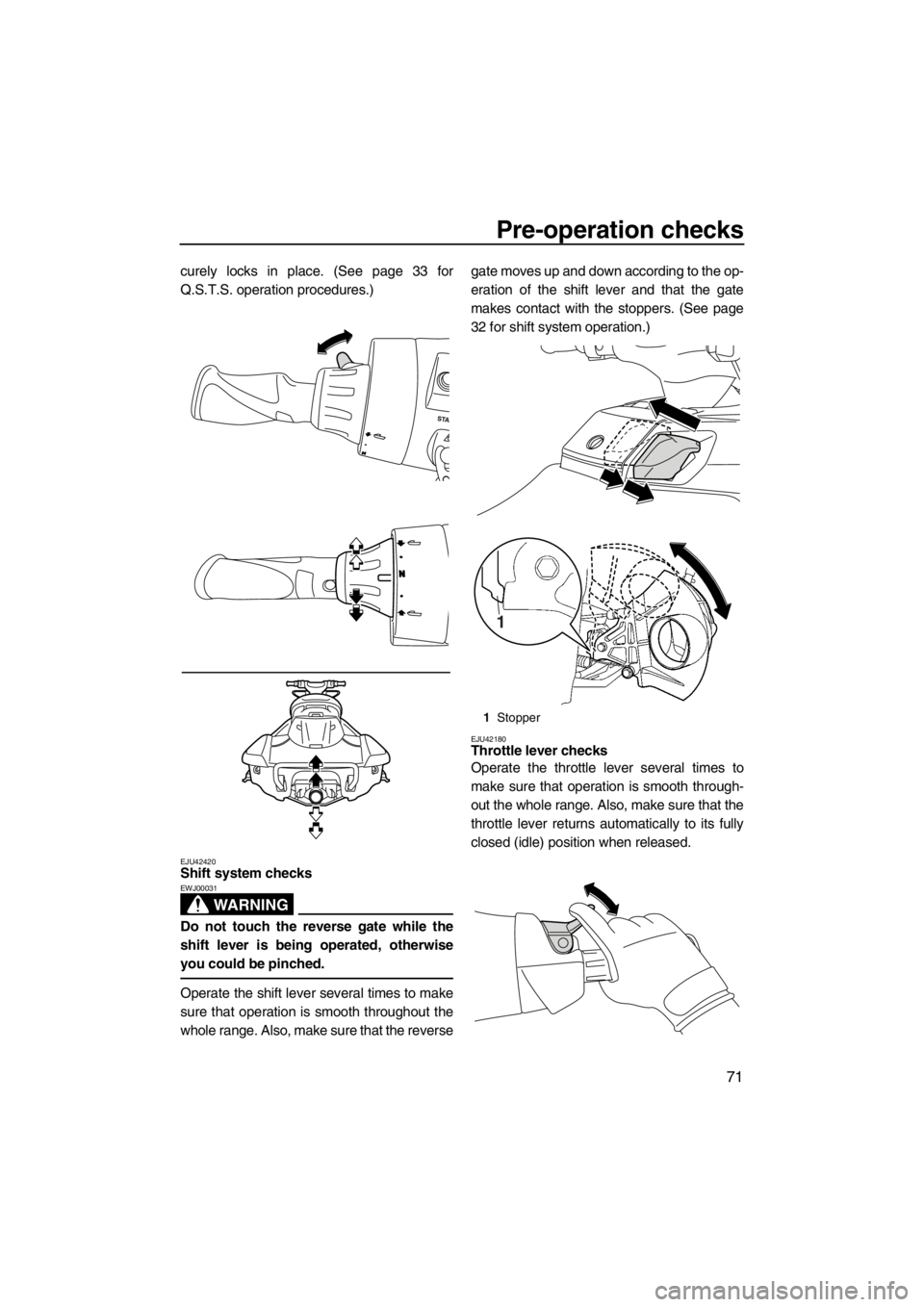
Pre-operation checks
71
curely locks in place. (See page 33 for
Q.S.T.S. operation procedures.)
EJU42420Shift system checks
WARNING
EWJ00031
Do not touch the reverse gate while the
shift lever is being operated, otherwise
you could be pinched.
Operate the shift lever several times to make
sure that operation is smooth throughout the
whole range. Also, make sure that the reversegate moves up and down according to the op-
eration of the shift lever and that the gate
makes contact with the stoppers. (See page
32 for shift system operation.)
EJU42180Throttle lever checks
Operate the throttle lever several times to
make sure that operation is smooth through-
out the whole range. Also, make sure that the
throttle lever returns automatically to its fully
closed (idle) position when released.
1Stopper
1
UF2S70E0.book Page 71 Wednesday, December 7, 2011 3:56 PM
Page 78 of 116
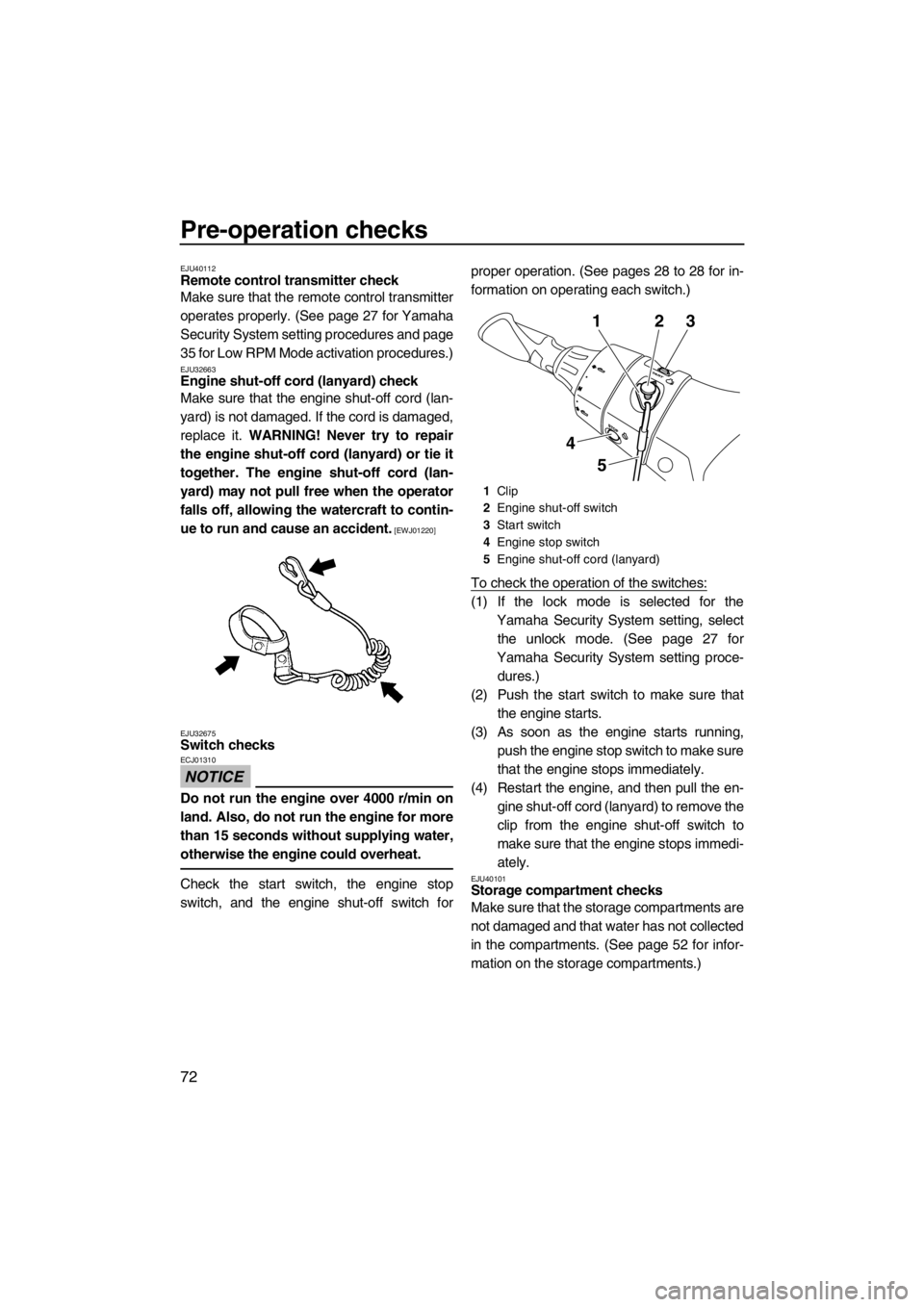
Pre-operation checks
72
EJU40112Remote control transmitter check
Make sure that the remote control transmitter
operates properly. (See page 27 for Yamaha
Security System setting procedures and page
35 for Low RPM Mode activation procedures.)
EJU32663Engine shut-off cord (lanyard) check
Make sure that the engine shut-off cord (lan-
yard) is not damaged. If the cord is damaged,
replace it. WARNING! Never try to repair
the engine shut-off cord (lanyard) or tie it
together. The engine shut-off cord (lan-
yard) may not pull free when the operator
falls off, allowing the watercraft to contin-
ue to run and cause an accident.
[EWJ01220]
EJU32675
Switch checks
NOTICE
ECJ01310
Do not run the engine over 4000 r/min on
land. Also, do not run the engine for more
than 15 seconds without supplying water,
otherwise the engine could overheat.
Check the start switch, the engine stop
switch, and the engine shut-off switch forproper operation. (See pages 28 to 28 for in-
formation on operating each switch.)
To check the operation of the switches:
(1) If the lock mode is selected for the
Yamaha Security System setting, select
the unlock mode. (See page 27 for
Yamaha Security System setting proce-
dures.)
(2) Push the start switch to make sure that
the engine starts.
(3) As soon as the engine starts running,
push the engine stop switch to make sure
that the engine stops immediately.
(4) Restart the engine, and then pull the en-
gine shut-off cord (lanyard) to remove the
clip from the engine shut-off switch to
make sure that the engine stops immedi-
ately.
EJU40101Storage compartment checks
Make sure that the storage compartments are
not damaged and that water has not collected
in the compartments. (See page 52 for infor-
mation on the storage compartments.)
1Clip
2Engine shut-off switch
3Start switch
4Engine stop switch
5Engine shut-off cord (lanyard)
132
5
4
UF2S70E0.book Page 72 Wednesday, December 7, 2011 3:56 PM
Page 79 of 116
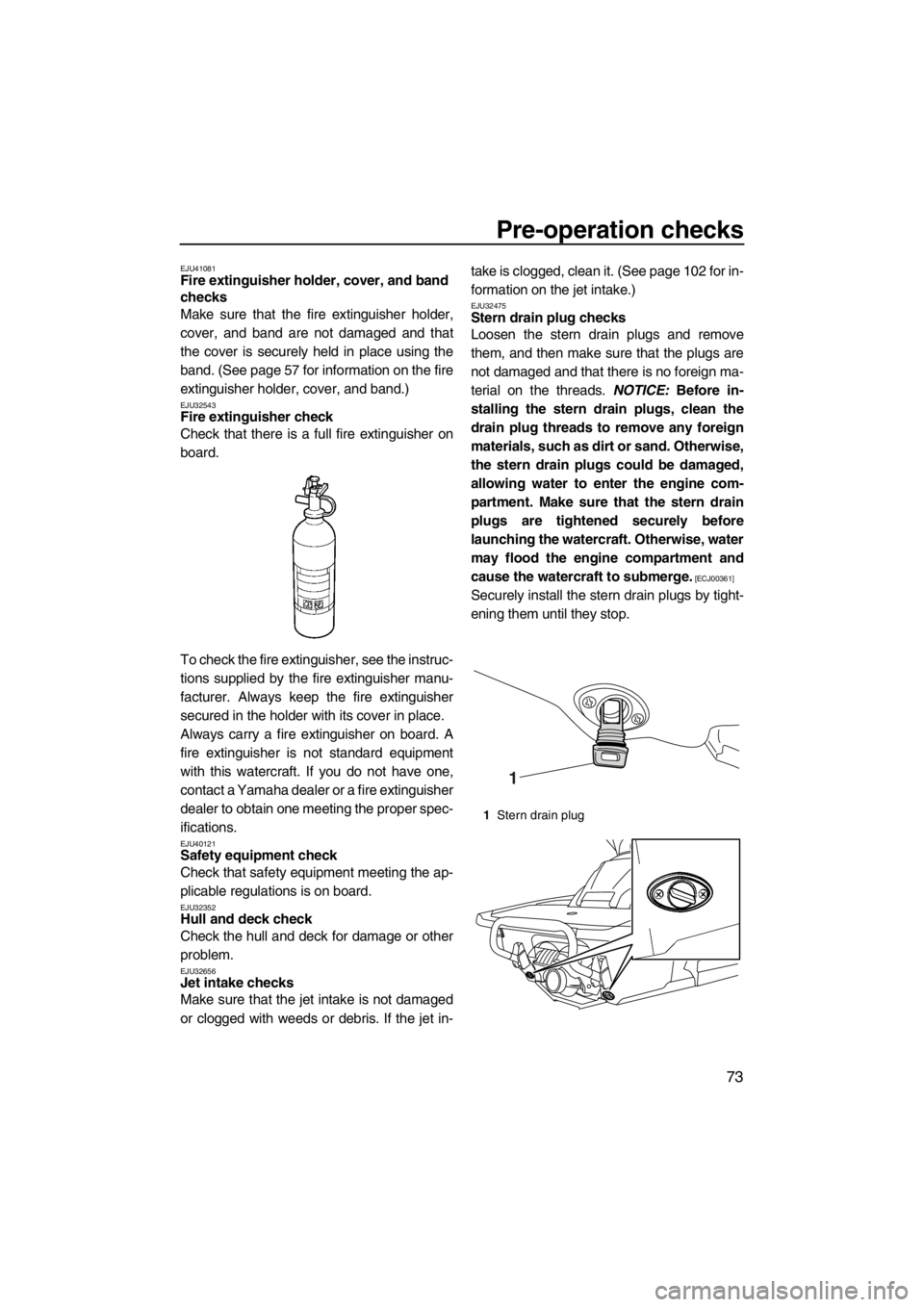
Pre-operation checks
73
EJU41081Fire extinguisher holder, cover, and band
checks
Make sure that the fire extinguisher holder,
cover, and band are not damaged and that
the cover is securely held in place using the
band. (See page 57 for information on the fire
extinguisher holder, cover, and band.)
EJU32543Fire extinguisher check
Check that there is a full fire extinguisher on
board.
To check the fire extinguisher, see the instruc-
tions supplied by the fire extinguisher manu-
facturer. Always keep the fire extinguisher
secured in the holder with its cover in place.
Always carry a fire extinguisher on board. A
fire extinguisher is not standard equipment
with this watercraft. If you do not have one,
contact a Yamaha dealer or a fire extinguisher
dealer to obtain one meeting the proper spec-
ifications.
EJU40121Safety equipment check
Check that safety equipment meeting the ap-
plicable regulations is on board.
EJU32352Hull and deck check
Check the hull and deck for damage or other
problem.
EJU32656Jet intake checks
Make sure that the jet intake is not damaged
or clogged with weeds or debris. If the jet in-take is clogged, clean it. (See page 102 for in-
formation on the jet intake.)
EJU32475Stern drain plug checks
Loosen the stern drain plugs and remove
them, and then make sure that the plugs are
not damaged and that there is no foreign ma-
terial on the threads. NOTICE: Before in-
stalling the stern drain plugs, clean the
drain plug threads to remove any foreign
materials, such as dirt or sand. Otherwise,
the stern drain plugs could be damaged,
allowing water to enter the engine com-
partment. Make sure that the stern drain
plugs are tightened securely before
launching the watercraft. Otherwise, water
may flood the engine compartment and
cause the watercraft to submerge.
[ECJ00361]
Securely install the stern drain plugs by tight-
ening them until they stop.
1Stern drain plug
1
UF2S70E0.book Page 73 Wednesday, December 7, 2011 3:56 PM
Page 80 of 116
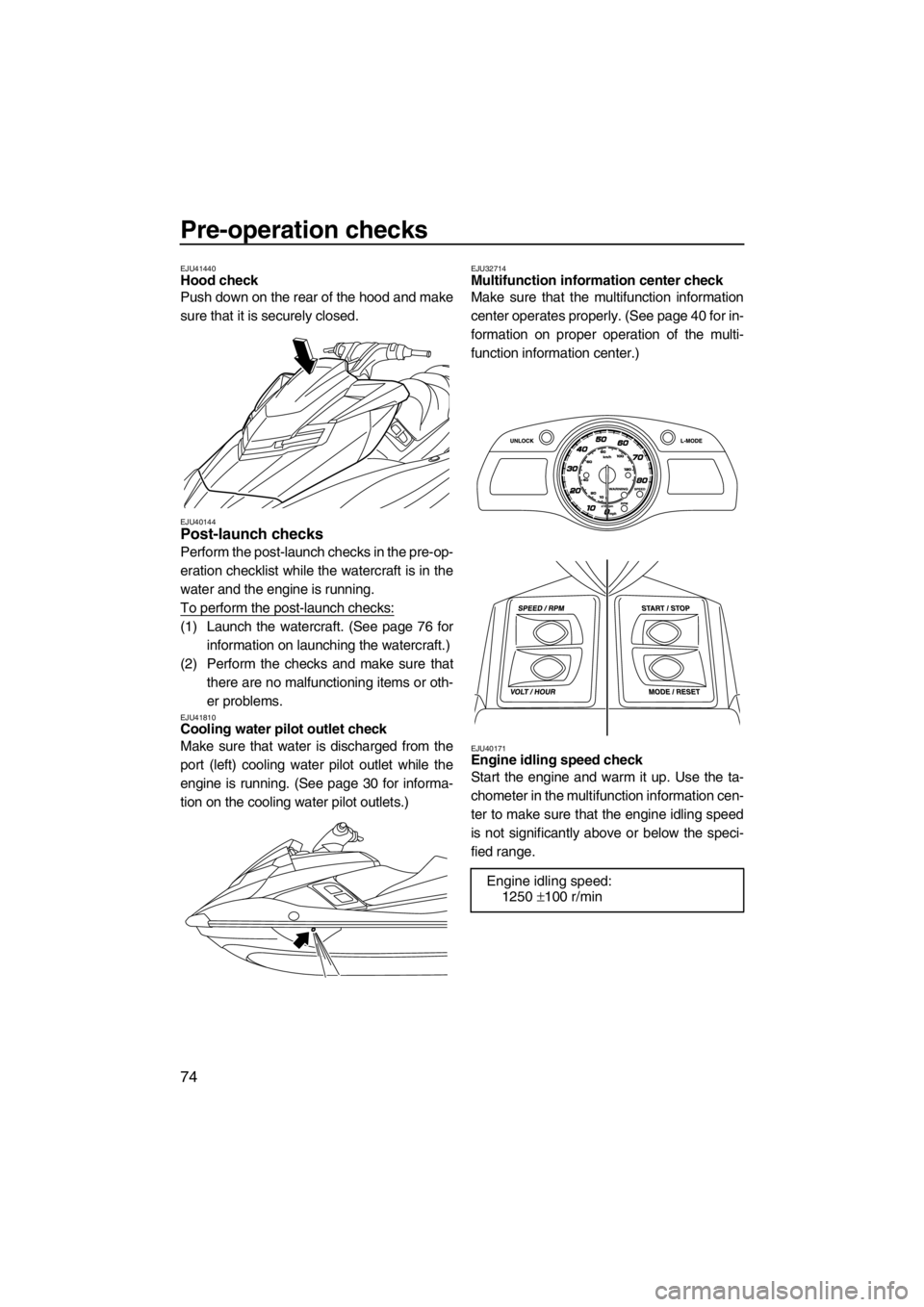
Pre-operation checks
74
EJU41440Hood check
Push down on the rear of the hood and make
sure that it is securely closed.
EJU40144Post-launch checks
Perform the post-launch checks in the pre-op-
eration checklist while the watercraft is in the
water and the engine is running.
To perform the post-launch checks:
(1) Launch the watercraft. (See page 76 for
information on launching the watercraft.)
(2) Perform the checks and make sure that
there are no malfunctioning items or oth-
er problems.
EJU41810Cooling water pilot outlet check
Make sure that water is discharged from the
port (left) cooling water pilot outlet while the
engine is running. (See page 30 for informa-
tion on the cooling water pilot outlets.)
EJU32714Multifunction information center check
Make sure that the multifunction information
center operates properly. (See page 40 for in-
formation on proper operation of the multi-
function information center.)
EJU40171Engine idling speed check
Start the engine and warm it up. Use the ta-
chometer in the multifunction information cen-
ter to make sure that the engine idling speed
is not significantly above or below the speci-
fied range.
Engine idling speed:
1250 ±100 r/min
UF2S70E0.book Page 74 Wednesday, December 7, 2011 3:56 PM